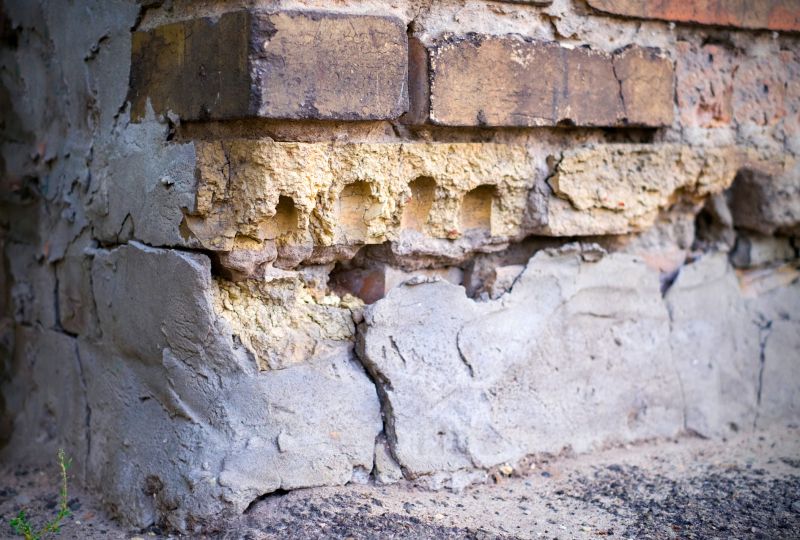Top-Rated Foundation Repair Products for Durable Foundations
Choose from the most highly rated products designed to improve and maintain the stability of your home's foundation.
 Foundation repairs are a critical aspect of maintaining the structural integrity of a building, especially in regions like Broomfield, CO, where soil conditions and weather patterns can impact the stability of structures. Selecting appropriate products for foundation repair involves understanding various solutions designed to address different types of foundation issues, such as settling, cracking, or shifting. These products are engineered to stabilize, lift, and reinforce foundations, helping to prevent further damage and ensure safety.
Foundation repairs are a critical aspect of maintaining the structural integrity of a building, especially in regions like Broomfield, CO, where soil conditions and weather patterns can impact the stability of structures. Selecting appropriate products for foundation repair involves understanding various solutions designed to address different types of foundation issues, such as settling, cracking, or shifting. These products are engineered to stabilize, lift, and reinforce foundations, helping to prevent further damage and ensure safety.
Top Overall Option
Polyurethane Foam Injection System
Polyurethane foam injection systems are versatile and effective for stabilizing and lifting foundations affected by soil settlement or minor shifting. They work by expanding beneath the slab or foundation to fill voids and exert upward pressure, helping to restore levelness and prevent future movement. These systems are often praised for their quick application, minimal invasiveness, and ability to adapt to various foundation types. While not suitable for all severe cases, they serve as a practical solution for many foundation stabilization needs in residential and commercial settings.
Types of Products For Foundation Repairs
Concrete Underpinning Piers
Support systems designed to transfer the load of a structure to stable soil layers below the foundation.
Epoxy Crack Injection Kits
Materials used to seal and reinforce cracks in concrete foundations, preventing water intrusion and further damage.
Steel Push Piers
Heavy-duty piers that are hydraulically driven beneath the foundation to provide stable support.
Helical Piles
Rotatable steel shafts that are screwed into the ground to provide foundation support, suitable for various soil conditions.
Polyurethane Foam Injection Systems
Expandable foam used to fill voids and lift sinking slabs or foundations.
Mudjacking / Slab Jacking
A process that raises sunken concrete slabs by injecting a mixture of mud, grout, or foam beneath them.
Soil Stabilization Grouts
Specialized grouts used to improve soil bearing capacity and reduce settlement.
Foundation Bolts and Anchors
Hardware used to reinforce and secure foundation elements to resist movement.
Drainage Systems
Solutions designed to redirect water away from foundations to prevent moisture-related issues.
Moisture Barriers
Materials installed to control water vapor and moisture infiltration in basement or crawl space areas.
Popular Choices
Commonly used for supporting and stabilizing foundations affected by settlement.
Widely used for sealing cracks and restoring the structural integrity of concrete foundations.
Popular for quick and minimally invasive slab lifting and stabilization.
Preferred for their versatility and ability to support various foundation types.
Frequently chosen for raising uneven concrete slabs in driveways and sidewalks.
Commonly installed to improve water management around foundations.
Popular hardware for reinforcing and stabilizing existing structures.
Often selected to improve ground conditions before or during foundation repair.
Used for leveling uneven slabs and maintaining surface stability.
Widely used to reduce basement humidity and prevent moisture-related foundation issues.
Foundation repair products come in many forms, each suited to specific problems and construction scenarios. From underpinning systems that provide additional support to epoxy injections that seal cracks, the range of options allows homeowners and contractors to choose solutions tailored to their needs. Proper installation and selection are essential to achieve effective results, making it important to consider factors like soil type, foundation material, and the severity of the damage.
In addition to structural products, there are auxiliary tools and accessories such as hydraulic jacks, leveling compounds, and moisture control systems that support the repair process. These products help in lifting and leveling uneven foundations, filling voids beneath slabs, or preventing future issues caused by soil movement. When considering foundation repair products, it is advisable to consult with professionals to assess the specific conditions and select the most appropriate solutions.
Ultimately, investing in the right foundation repair products can extend the lifespan of a building and maintain its safety and value. Whether dealing with minor cracks or major shifts, understanding the variety of available products and their applications can aid in making informed decisions. Properly chosen and installed products contribute to the stability and durability of structures, especially in areas like Broomfield where ground conditions may fluctuate.
Key Buying Considerations
- Assess the severity and type of foundation issue to determine the appropriate repair solution.
- Understand the soil conditions and how they influence the choice of products and methods.
- Consider the compatibility of repair products with existing foundation materials such as concrete, brick, or stone.
- Evaluate the long-term durability and performance of the repair products under local climate conditions.
- Look into the installation process and whether professional assistance is recommended or required.
- Review the ease of application and whether the products are suitable for DIY projects or professional use.
- Check for warranty options or guarantees from manufacturers or contractors.
- Consider the potential impact on property value and the importance of code compliance.
- Research the availability of replacement parts or additional components for future repairs.
- Evaluate the cost-effectiveness of different products in relation to the scope of the repair needed.
- Determine if additional services such as moisture management or drainage improvements are necessary.
- Review safety guidelines and handling instructions for each product type.
- Explore customer reviews and expert opinions to gauge product effectiveness and reliability.
- Ensure that the selected products are suitable for your specific foundation type and damage level.
- Consider environmental and site-specific factors that might influence product performance.
